By planting giant sunflowers you can grow a beautiful privacy screen in one season, create a child’s play house, grow a hedge, or achieve a world record. These huge sunflower varieties grow up to a foot each week, once their roots are established. Their flowers are huge too, and can be as big as a dinner plate. But winning a giant sunflower competition requires upping your sunflower growing strategies. These tips will help you be in the winner’s circle at the country fair.
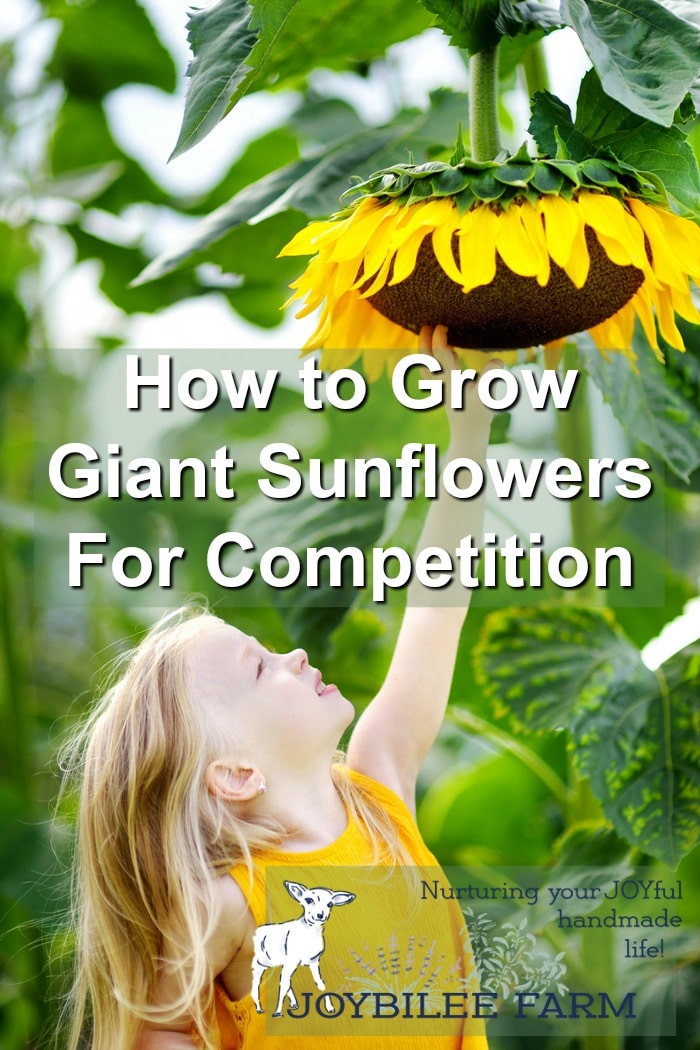
Benefits of growing giant sunflowers
- Sunflowers of all stripes offer nectar for pollinators. The giant sunflowers also offer pollen, an important pollinator food. Since giant sunflowers grow so fast, they can create a privacy hedge, shade, or even a play environment within a couple of months of planting.
- Sunflowers also offer feed for livestock especially rabbits and poultry. Thinnings, leaves, and eventually the ripe seeds can be offered to livestock freely.
- Giant sunflowers also provide seeds for snacking on, for birdseed, and pressing for sunflower oil.
- Growing giant sunflowers is a quick way to beautify a yard or farm while shielding unsightly areas.
- Sunflower buds are edible for humans and can be cooked like artichoke or used as sprouts.
- When you are growing sunflowers for a wedding, giant sunflowers make a lovely backdrop for wedding photos.
- Giant sunflowers can be used for farm mazes to increase agritourism opportunities.
- Giant sunflowers also work well for creating playhouses and secret spaces in the children’s garden.
- Giant sunflowers can be grown for competition.
- Giant sunflowers increase the interest in your landscape since they look beautiful at all stages of growth
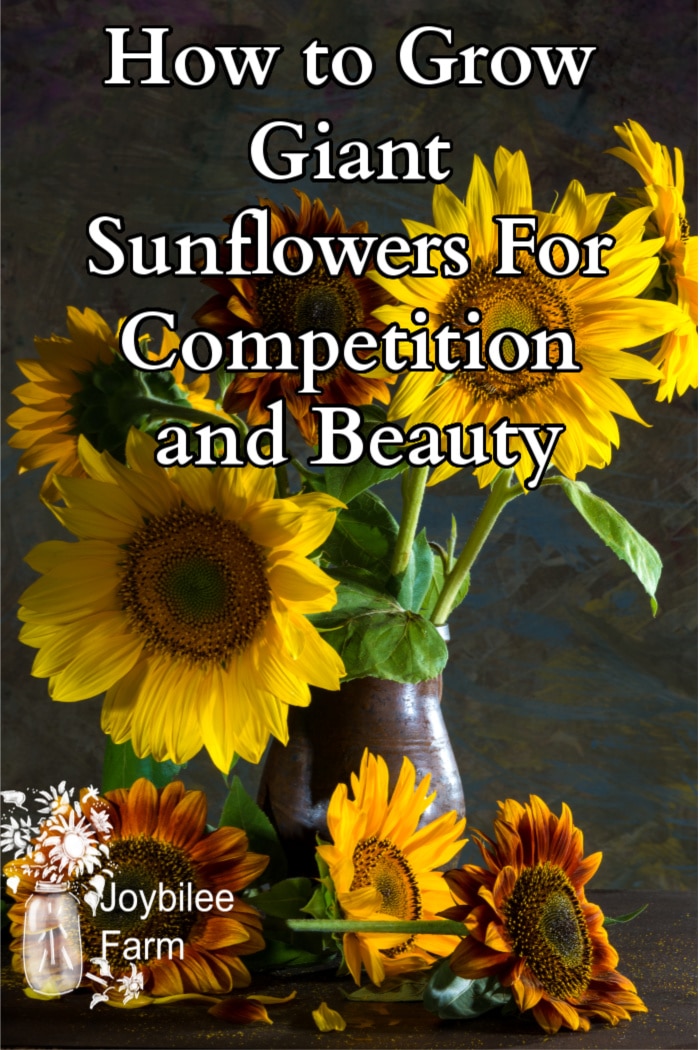
Choose the right giant sunflower variety
When growing giant sunflowers it’s important to choose the right varieties for your purposes. The world’s tallest sunflower measured 9.17m (30 feet, 1 inch) and was grown in 2014 in Germany by veteran record holder Hans-Peter Schiffer of Germany. This world record sunflower was the product of years of plant selection and seed saving, as well as ideal growing conditions that year. But while it may take you a few years to win the world record, starting at the local competition might be entirely within your reach.
Open Pollinated varieties
Open pollinated sunflower varieties grow true from seed. By starting with open pollinated seed you can begin the seed selection by choosing the tallest plant and the plant with the largest flower each year to save seed for growing out the following year. By selecting the plants that grow best in your climate and growing them each year you will gradually improve the height and flower size of these annual flowers.
These heirloom sunflowers are good choices for competition growing. All are yellow or golden flowered. So far no one has done the genetic work to create a red or maroon giant sunflower. Maybe that’s a plant breeding challenge you’d like to take on.
- Russian Giant (9 to 12 feet in height, 20 inch flowers)
- Mammoth Grey Stripe (8 to 12 feet, 12 inch flowers)
- American Giant (14 feet, 12 inch flowers)
- Titan (12 feet tall, 24 inch flowers)
- Mongolian Giant Sunflower (14 feet, 18 inch flowers)
- Skyscraper sunflower (12 feet, 14 inch flowers)
- Giganteus (12 feet tall, 18 inch flowers)
- Evening Sun (6 to 9 feet, 10 inch flowers) — bicolor
Hybrid Giant Sunflowers
Hybrid sunflowers have been bred epecially for giant sunflower competitions. These flowers are uniform and have many features that make them ideal for growing competition size sunfowers that don’t need staking. However, you won’t be able to save the seed year after year with hybrid varieties. Many of the hybrid sunflowers were created using a sterile male to replace the female parent. They will not produce seed that is true to the parent. In fact, they might not produce seed at all in future generations..
Hybrid sunflowers grow to amazing heights in the climate that they were bred for, some over 20 feet, due to hybrid vigor. But if you have a shorter, wetter, drier, or colder season they might not perform as well in your garden.
- Sunzilla (16 to 24 feet tall, 14 inch flower)
- Kong (up to 16 feet tall, 10 inch flowers)(branching)
- Paul Bunyan (15 feet, 20 inch flowers)
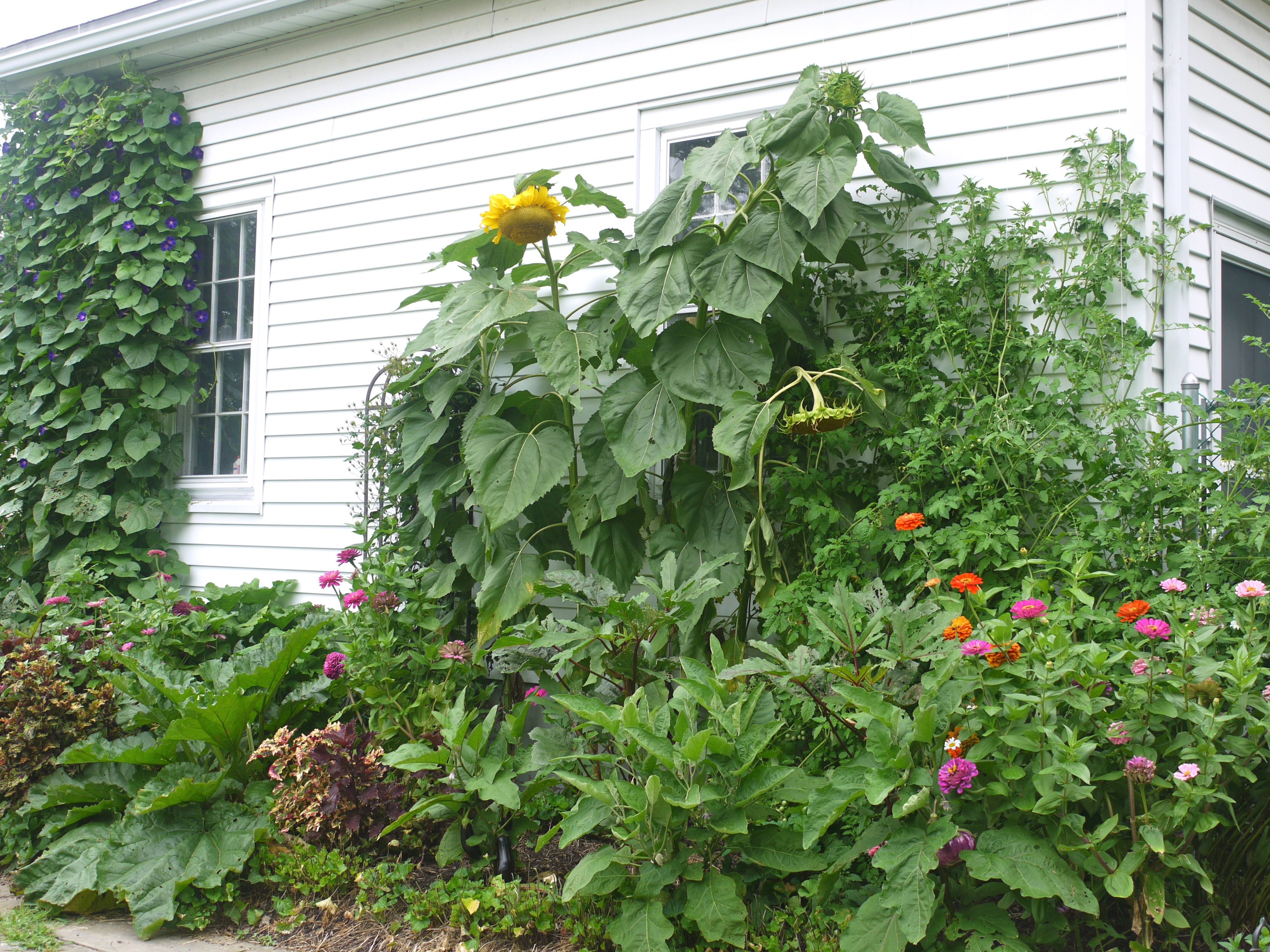
Picture used with permission of Susan Vinskofski, Learning and Yearning.
When to plant giant sunflowers
Plant the seeds for giant sunflowers in the spot where you want them to grow, 2 weeks before the last expected frost date. They need about 75 to 120 days to produce viable seed.
What do giant sunflowers need to grow?
Plant these giants in full sun. All sunflowers need at least 6 to 8 hours of sunlight a day and more is better. But giant sunflowers use the sun’s energy to fuel their massive growth, so the more hours of sunlight the plants receive the more robust their growth.
Before planting, cultivate the ground to a depth of at least 18 inches and amend the soil with well rotted compost, kelp meal, and liquid fish fertilizer. Add 1 teaspoon of borax to 1 1/2 cups of water and spread over a 15 foot row. Giant sunflowers are heavy feeders. To grow them to competition size they’ll need regular feedings of properly diluted, organic fish emulsion fertilizer once a week.
How much spacing do giant sunflowers need?
When growing giant sunflowers plant them directly in the ground where you want them to grow. Don’t try to start them indoors . They will push their roots into the soil more than 4 feet during the growing season, so you want to give them every opportunity to expand their roots, without hinderance.
Plant the seeds 3 inches apart in rows at least 2 feet apart. The more ground you give each plant the bigger the plant will grow.
When the sunflowers are 3 inches high remove the weakest, least vigorous seedlings leaving them in the row with one sunflower every 12 inches. Then when the sunflowers are 6 inches high remove every weaker seedling so that the sunflowers are 2 feet apart from each other in every direction.
If you are growing for competition, pick the strongest, tallest sunflower, with the sturdiest stem. Remove all competition within 4 feet of this plant. Mulch the soil well to hold in moisture and inhibit weeds. Treat this sunflower with extra care and attention.
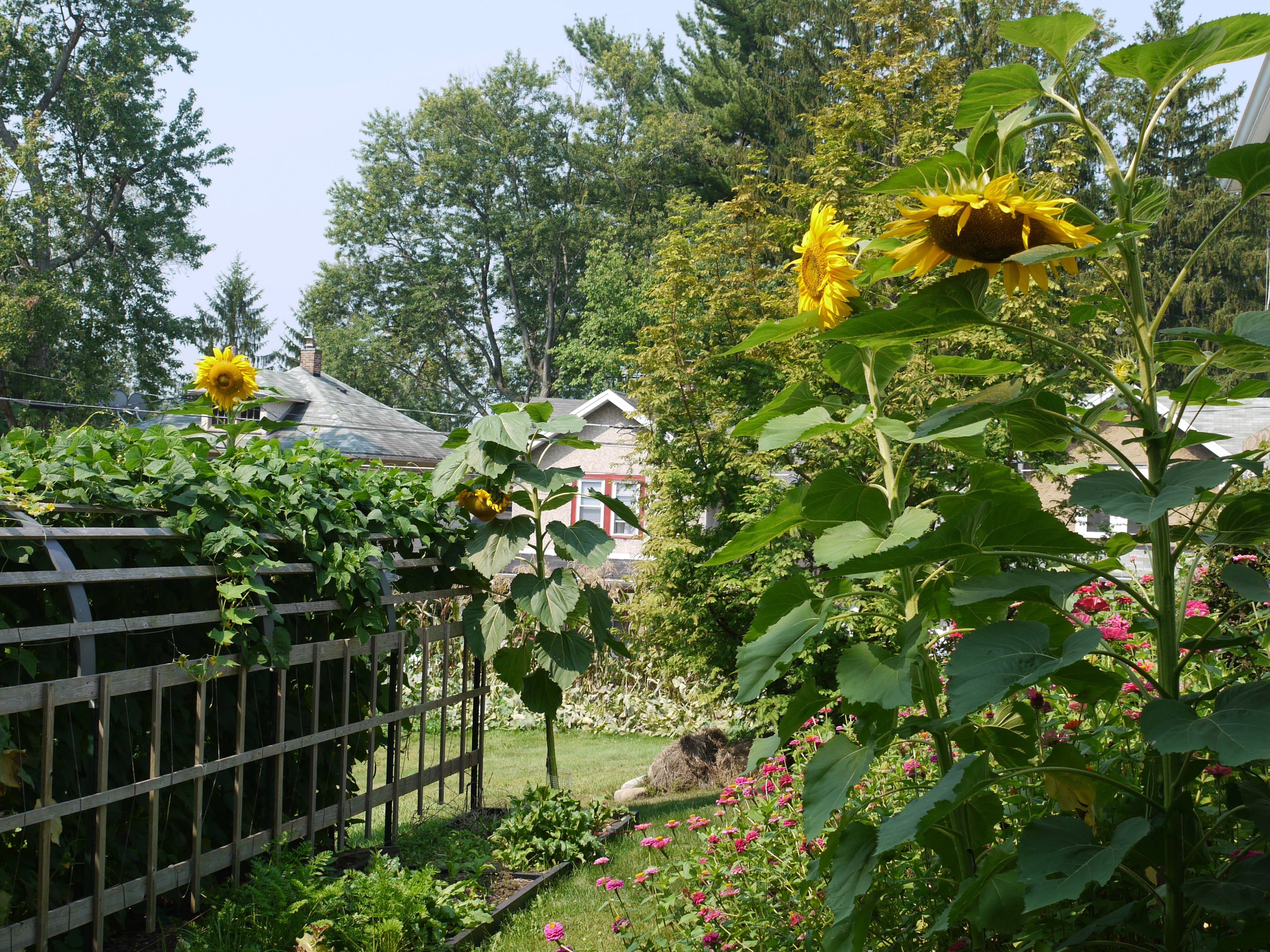
Picture used with permission of Susan Vinskofski, Learning and Yearning
Giant sunflower cultivation
Keep the ground moist with frequent watering until the sunflowers are above the ground. Once the plants become established and are growing well, they should be watered once a week.
Generally, sunflowers require little care other than watering. The fertility in the soil is enough to produce blooms. However, for competition sunflowers, weekly feedings of properly diluted fish emulsion encourages vigorous growth. To fertilize actively growing sunflowers, make a shallow trench around the plant about 12 to 18 inches from the stem. Pour the fertilizer into the trench. Avoid splashing fertilizer on the stalk or leaves

Special considerations for competition sunflowers
For the tallest sunflowers water with compost tea or properly diuted fish emulsion once a week.
For the biggest flower head, remove side shoots allowing the plant to focus energy on the main flower head.
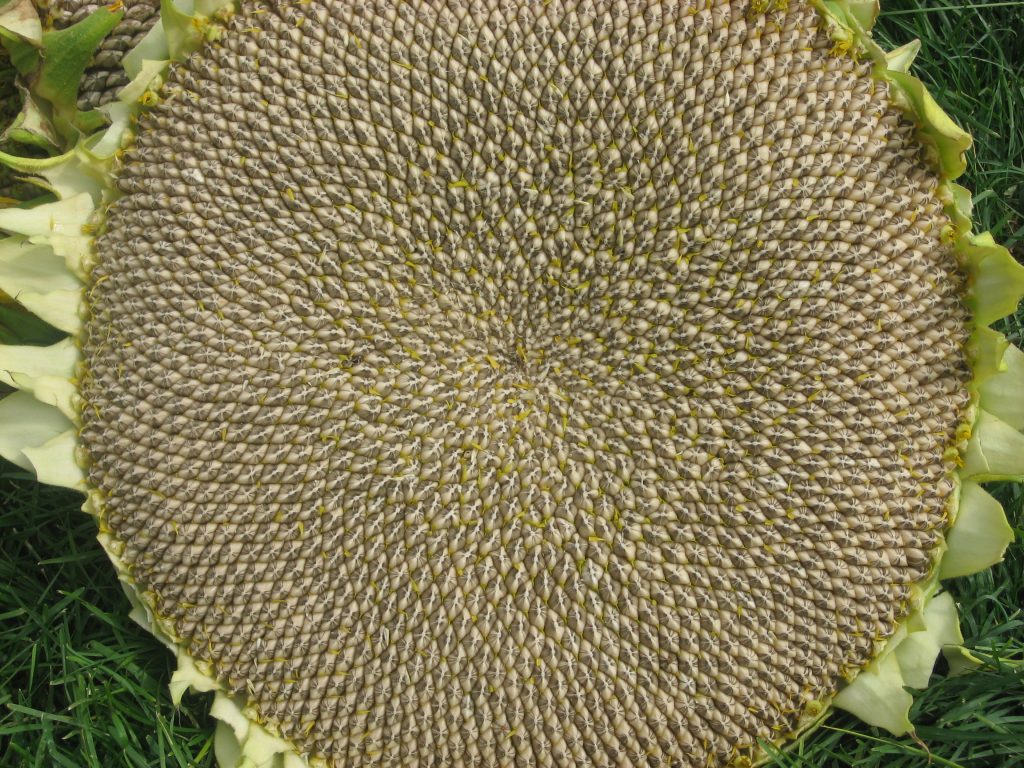
Picture used with permission of Tessa Zundel, Homestead Lady.
For even bigger sunflowers next year
If you are growing heirloom sunflowers, save the seed from this year’s largest sunflowers to plant in next years garden. Select the tallest sunflower as well as the sunflower with the largest flower head for your seed stock. Repeat this selection annually to continually improve your giant sunflower and acclimatize it to your unique growing conditions.
While you can also save the seed from hybrid sunflowers they may not grow true to type. So if you plan to save your own seed from year to year choose an heirloom variety to start with.
Use any extra seed to make sunflower sprouts and sunflower microgreens this winter.
How do sunflowers grow?
Sunflower problems
Aphids are often herded onto sunflowers because of the abundance of nectar. Planting nasturtiums nearby can act as an aphid magnet so that your competition sunflowers are aphid free. Generally, sunflowers are tough and not set back by aphids, but competition giant sunflowers might need extra help.
Your giant sunflower may need staking to prevent it from being blown over in a strong wind.
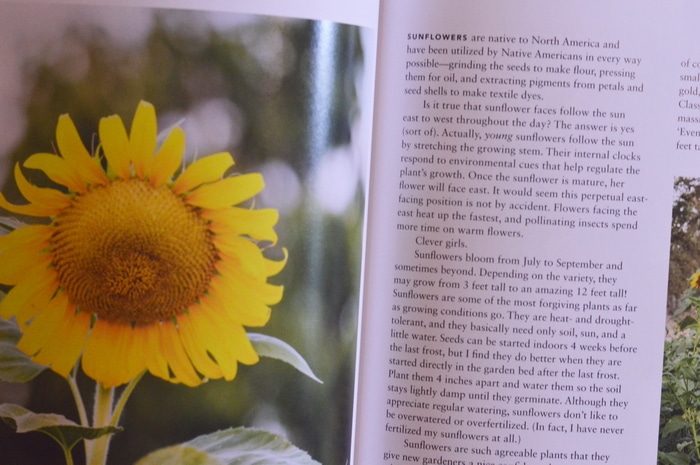
Heliotropism in sunflowers
Young sunflowers track the sun from east to west throughout the day. While blooming sunflowers turn East and hold the morning sun. This sun tracking is called, “heliotropism” and is common in other asteraceae plants like daisy and . Chris MacLaughlin in her new book Growing Heirloom Flowers, Bring the Vintage Beauty of Heritage Blooms to Your Modern Garden tells us that young sunflowers follow the sun by
…stretching the growing stem. Their internal clocks respond to environmental cues that help regulate the plant’s growth. Once the sunflower is mature, her flower will face east. It would seem this perpetual east-facing position is not by accident. Flowers facing the east heat up the fastest, and pollinating insects spend more time on warm flowers. Clever girls.
Sunflowers are heat and drought tolerant. Although the giant varieties grow taller with ample supplemental water and weekly fertilizer applications, Chris MacLaughlin says she never fertilizes her sunflowers.
While Growing Heirloom Flowers mentions sunflowers only in general, with a 2 page spread devoted to this favorite heirloom flower, it doesn’t focus on growing competition worthy giant sunflowers. However, since flower growers never plant just one flower, Growing Heirloom Flowers is just the right inspiration to fill out the rest of your flower garden.
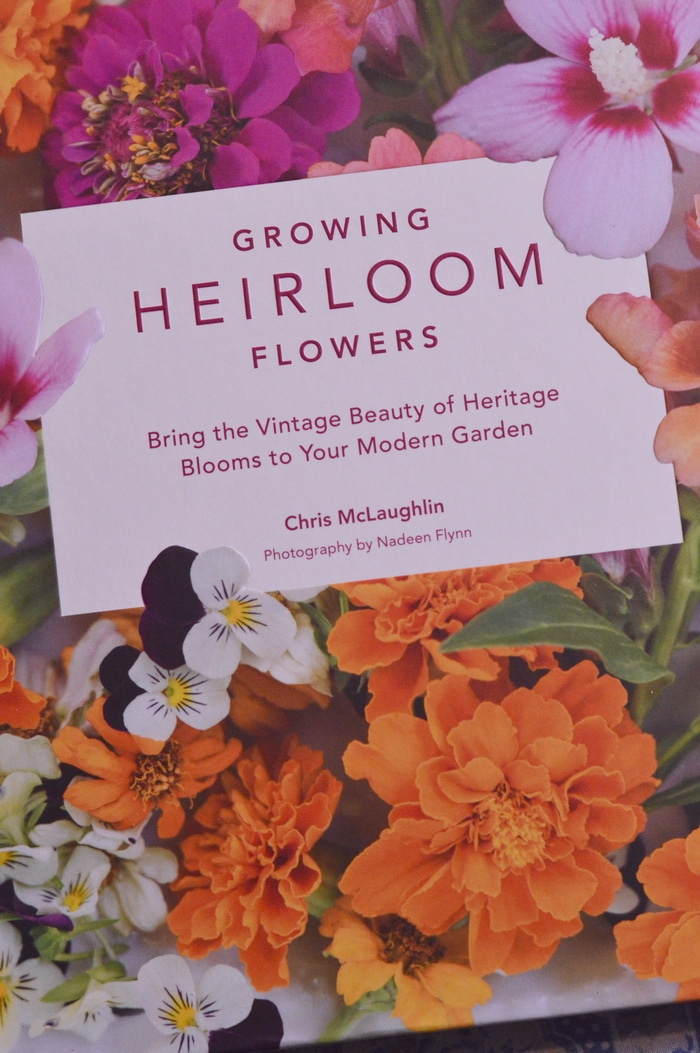
Growing Heirloom Flowers is a gorgeous book
Chris MacLaughlin’s newest book is full of eye candy for the heirloom gardener. Each flower is covered in a two page spread that includes a gorgeous picture of the flower in full bloom. Each flower description includes the history of when the flower was introduced to North American flower gardeners, as well as interesting facts and growing information. But it doesn’t read like a seed catalog. Instead, this stunning book captures the “WHY” for each flower species and leads the reader to explore the real reason for growing flowers.
Are you growing flowers for a cutting garden, so that you can bring beautiful bouquets into your home? Ms. MacLaughlin’s got you covered with step by step flower arranging tutorials and tips. Will you bring your heirlooms into the kitchen and use them for food? There are recipes and lists of edible heirlooms to experiment with.

Perhaps your reason for planting gorgeous heirloom flowers is to craft with them. Growing Heirloom Flowers covers flower crowns, bath salts, bath scrubs, flower pounding, eco-printing, natural dyes, and many other crafty uses for heirloom flowers, giving you more reasons to plant them.
Growing Heirloom Flowers is the ideal book for heirloom seed enthusiasts, intermediate and experienced gardeners, and market growers. Those who have been fighting the elements to grow their own vegetables for many years will find fresh inspiration and relief in this book. There is more to gardening than food. A beautiful garden, full of heirloom flowers in bloom is a sanctuary. It also offers food for pollinators, attracts beneficial predatory insects, and fills the neighborhood with beauty — and you get might even get more vegetables.

What’s missing in Growing Heirloom Flowers?
The book is not a seed catalog. It doesn’t give you all the cultural information you need to plant and grow these gorgeous heirloom flowers. You’ll find that information on the seed packet. But the book does give you enough information to peak your interest and inspire your garden planning. I’d strongly suggest using this book to find your favorite flower candidates for your own garden, and then use that list to check the “days to bloom” at Johnny’s Select Seed, Renee’s, or Wild Seed Farm.
While Growing Heirloom Flowers is inspiring, the beginning gardener may find the book frustrating for it’s lack of beginner information, often found in early gardening books. The book assumes the reader already knows their own growing zone and frost-free days, how to prepare the soil for planting, and how to make compost. If you are still looking for this kind of information for your garden, you’ll want to supplement Growing Heirloom Flowers with a book like this one.
Who is Chris MacLaughlin?
You might remember Chris from other books we’ve mentioned on the blog. Chris is the author of A Garden to Dye For and several other books in the gardening niche. Chris is a fiber artist, master gardener, natural dyer, and homesteader as well as a prolific author. Her body of work includes books on rabbit care, natural dyes, composting, heirloom vegetables, and more. This newest book is worthy of a place on the coffee table so don’t hide it in your bookcase. Take it out and enjoy the eye-candy from cover to cover.
Disclosure: I received a copy of this book for review purposes from the publisher. This is my honest opinion of this book.




My friend and I are gonna have a growing contest this year . To see who can grow the tallest sunflower! We both have grown them in the past but just for fun. This year we are getting serious.. I want to use your tips to grow my self a monster hybrid! I love all your suggestions. Wish me luck!
Good luck. That’s a massive sunflower.
Appreciate the information on fertilizer for the sunflower. I will try using this information to see if I can top this years height of 18’3”.
I have never lost such huge sunflowers, I would like to have this sunflower in my garden. Your writing is great, help me know how to grow beautiful sunflowers.